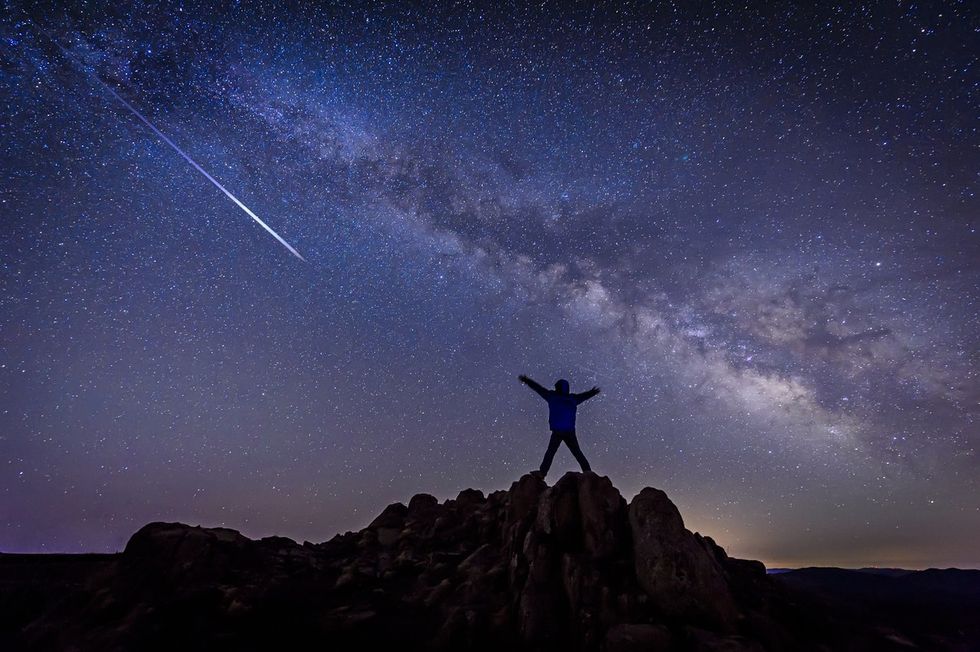Events like last year’s total solar eclipse remind us how exhilarating and awe-inspiring celestial events can be. But the moon passing in front of the sun isn’t the only reason to look up: Meteor showers can be a great excuse to lie out and take in the grandeur of the night sky. But unlike a once-in-a-lifetime passing comet or a lunar eclipse, you don’t necessarily have to wait as long to get your shooting star fix. In fact, you can catch the upcoming Lyrid meteor shower as it creates a dazzling display up above when it peaks this week.
RELATED: Is an Asteroid Really Hitting Earth in 2032? Scientists Set the Record Straight.
What are the Lyrids?
Whether you’re an astronomy buff or not, you might want to clear your evening calendar for later this week. After kicking off on April 17, the Lyrid meteor shower will hit its peak overnight on April 21 through the early morning hours of April 22, per NASA.
According to the space agency, the annual celestial event is one of the oldest in recorded history. Some written reports date back as far as 2,700 years, including one of the first noted in China in 678 BCE.
Similar to many other meteor showers, the fuel for this shooting star show comes from debris left behind by a passing object. In this case, it’s comet C/1861 G1 Thatcher, which orbits the sun once every 415.5 years. The “long period comet” (which refers to its lengthy orbital time) last reached perihelion—or its closest point to the sun—in 1861.
“Shooting stars” that make up the shower occur when particles left behind by Comet Thatcher hit the Earth’s atmosphere as our planet passes through its orbital path. But unlike other notable annual showers that produce long, lingering tails and streaks, the Lyrids are known for creating bright “fireballs” that light up the sky like a quick spark or explosion, according to NASA.
Some years can see a particularly active show.
Even though the Lyrids are an annual event, they’re not exactly the same from year to year. Typically, the shower produces a reliable 15 to 20 meteors per hour, according to Space.com. But during some years, “outbursts” can greatly increase activity, pushing numbers to about 100 per hour.
Unfortunately, it can be difficult to predict exactly when these banner years will occur. In the past, outburst years were reported in Virginia in 1803, Greece in 1922, Japan in 1945, and in the U.S. in 1982, according to NASA.
RELATED: 8 Amazing Things You Can See in the Night Sky Without a Telescope.
The Lyrids will also have a little company.
While scientists may not be able to pinpoint an especially active year, there is one added bonus that will add to the excitement. In an instance of “guest star” becoming almost too literal, the Eta Aquarid meteor shower will also be kicking off on April 20, just in time to be visible during the Lyrids’ peak.
This annual show—which is created by the dust left behind by Halley’s Comet—will peak on the night of May 5, bringing as many as 50 meteors per hour. And unlike the fireballs seen during the Lyrid shower, the Eta Aquarids are known for creating beautiful streaking “trains” that linger in the sky, according to NASA.
What’s the best way to watch the Lyrid meteor shower?
Like many things in life, getting the best meteor viewing experience comes down to a combination of luck and preparation. Local weather conditions and cloud cover can blot out any chances of catching “fireballs” in the sky, but they’re not the only consideration.
This year’s peak will also coincide with a 40 percent full moon, which can somewhat reduce visibility due to the increased lunar light, according to the American Meteor Society (AMS).
The rising moon is also expected to coincide as the meteor shower’s radiant—or the spot near the star Vega where the objects appear to originate—will rise higher in the sky along with the moon. This means what would normally be some of the best viewing times in the pre-dawn hours could get washed out, AMS says.
Even though you can’t control the moon’s glow, you can still afford yourself a better show by finding a viewing location that’s far from city lights and other sources of light pollution. Once you’re there, sit back on a blanket or comfortable reclining chair (while bundled up appropriately for the chilly spring evening weather, of course) and give your eyes about 30 minutes to adjust to the low-light conditions.
Content shared from bestlifeonline.com.

